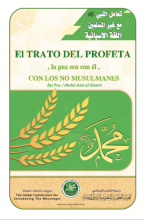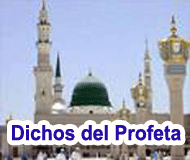Relató Abu Dharr (que Allah esté complacido con él) que algunos de los compañeros del Mensajero de Alá dijeron al Profeta (la paz sea con él): ¡Mensajero de Alá! Los ricos se han quedado con todas las recompensas, rezan como nosotros, ayunan como nosotros y dan en caridad lo que sobra de sus bienes. Dijo: “¿Es que acaso, Alá no os ha dado con que hacer caridad?, pues por cierto que decir subhanalla (Glorificado sea Alá) es caridad, decir Allahuakbar (Alá es el Supremo) es caridad, decir Alhamdulillah (las alabanzas pertenecen a Alá), decir La ilaha illa Allah (No hay dios sino Alá) es caridad, y ordenar el bien es caridad, así como prohibir el mal es caridad; Asimismo, en cada acto sexual de uno de vosotros hay caridad”. Dijeron asombrados: ¡Mensajero de Alá!, ¿Acaso satisfaciendo uno su deseo, se hace merecedor de recompensa? Dijo: “¿Acaso, si lo satisficiera ilícitamente, no se haría merecedor de castigo? pues de la misma manera, si lo satisface legalmente será recompensado”. (Transmitido por Muslim)
El profeta de la misericordia Site
Liga del Mundo Islámico - Organismo Mundial para la Presentación del Mensajero
We have already mentioned that the Messenger of Allâh (Peace be upon him) arrived in Madinah on Friday, 12th Rabi‘ Al-Awwal 1 A.H., i.e. September 27th. 622 A.D. and took the downstairs of Abi Ayyub’s house as a temporary residence.
The first task to which the Prophet (Peace be upon him) attended on his arrival in Madinah was the construction of a Mosque, in the very site where his camel knelt down. The land, which belonged to two orphans, was purchased. The Prophet (Peace be upon him) himself contributed to building the Mosque by carrying adobe bricks and stones while reciting verses:
“O Allâh! no bliss is there but that of the Hereafter, I beseech you to forgive the Emigrants and Helpers.”
The ground was cleared, of weeds and shrubs, palm trees and rubbish, the graves of the polytheists dug up and then levelled and the trees planted around. The Qiblah (the direction in which the Muslims turn their faces in prayer) was constructed to face Jerusalem; two beams were also erected to hold the ceiling up. It was square in form, each side measuring approximately 100 yards, facing towards the north and having three gates on each of the remaining sides. Nearby, rooms reserved for the Prophet’s household were built of stones and adobe bricks with ceilings of palm leaves. To the north of the Mosque a place was reserved for the Muslims who had neither family nor home. The Adhân (summoning the Muslims to the Mosque by the Call for prayer) was initiated at this early stage of post-migration era. The Mosque was not merely a locus to perform prayers, but rather an Islamic league where the Muslim’s were instructed in Islam and its doctrines. It served as an assembly place where the conflicting pre-Islamic trends used to come to terms; it was the headquarter wherein all the affairs of the Muslims were administered, and consultative and executive councils held.
The Mosque being thus constructed, the Prophet (Peace be upon him) next turned his attention to cementing the ties of mutual brotherhood amongst the Muslims of Madinah, Al-Ansar (the Helpers) and Al-Muhajirun (the Emigrants). It was indeed unique in the history of the world. A gathering of 90 men, half of whom Emigrants and the others Helpers assembled in the house of Anas bin Malik where the Prophet (Peace be upon him) gave the spirit of brotherhood his official blessing. When either of the two persons who had been paired as brothers, passed away, his property was inherited by his brother-in-faith. This practice continued till the following verse was revealed at the time of the battle of Badr, and the regular rule of inheritance was allowed to take its usual course:
******




